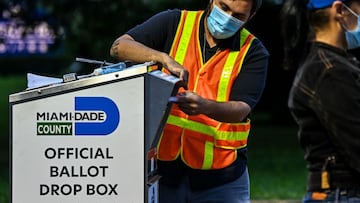US Election 2020: how will mail votes affect the results?
Record-smashing numbers of mail-in ballots have been cast this year owing to the covid-19 pandemic. It's slowing vote counting, and could affect result.

US Election 2020 live: Trump and Biden results | Nevada, Arizona, Pennsylvania, Georgia...
It's the day after election day, and all eyes are on absentee and mail-in ballots. At the time of writing, these key states among others are still to be called as counting of mail-in votes continues into Wednesday morning: Michigan, North Carolina, Pennsylvania, Wisconsin. For deadlines on three key Rust Belt state counting, see our full article.
According to the Pew Research Center, mail-in ballots accounted for just over half of this year’s primary votes cast. That was roughly double the mail-in share of the vote in the 2018 and 2016 general elections.
California, Nevada, New Jersey and Vermont are mailing ballots to all registered voters for the first time this year, as are most of Montana’s counties and the District of Columbia. They join five other states that had already shifted to all-mail elections before the coronavirus outbreak: Colorado, Hawaii, Oregon, Utah and Washington state.
How could mail-votes affect turnout?
Concerns about voting in person due to the covid-19 pandemic are thought to be behind the steep rise in mail-in voting this year. Some 60% of people eligible to vote in US presidential elections usually turn in a ballot. Those who don’t vote give reasons including a lack of paid time off on Election Day (always a Tuesday in America) and long queues at polling places.
Democrats have continued to dominate the initial balloting, but Republicans are narrowing the gap. GOP voters have begun to show up as early in-person voting, a sign that many heeded President Donald Trump's unfounded warnings about mail-voting fraud. https://t.co/WoyKh6tYIe
— WLOS (@WLOS_13) October 26, 2020
Nature says that there is research suggesting that mail-in voting could increase overall voter turnout. This is likely to slightly benefit Democrats on the whole.
On balance, according to a recent Pew Research Center survey 40% of Biden supporters who live in states that require an excuse that is not coronavirus-related to vote by mail say they would like to vote by mail this year, but just 10% of Trump supporters in these states say the same.
Is there mail-in voting fraud?
Unsubstantiated claims of fraud in the mail-in voting system have been perpetuated by president Trump. At the least this messaging could discourage or demotivate a sector of those Democratic voters who were thinking about voting by mail this year due to pandemic concerns.
It is widely accepted that fraud is exceptionally rare in postal voting, thanks to a range of security measures including identity verification, ballot tracking and the efforts of the US Postal Service police force.
Vox reports that in Oregon, which has been voting by mail for about two decades, officials referred 54 cases of possible voter fraud to law enforcement in 2016. Of those, 22 people, representing just 0.0001% of all ballots cast that year, were found guilty of having voted in two states.
“You’re more likely to get struck by lightning than have someone impersonate you at the ballot box,” says Sonni Waknin, a fellow with the University of California’s Voting Rights Project talking to Nature.
How could more mail-in votes affect the election result?
For starters, it’s widely acknowledged that Democrats will submit more votes by post than Republicans. In a New York Times and Siena College poll last month, 28% of Democrats said they planned to vote in person on election day, compared with 68% of Republicans.
Postal votes are slightly more likely to be undercounted, and undercounting could disproportionately affect people from certain groups, many of whom tend to vote Democrat.
Pelosi on mail-in voting: "I hope people will not depend on the mail, because [Republicans] have done all they can to dismantle the postal system."
— CBS News (@CBSNews) October 29, 2020
She notes that the Postal Service has already said it may be too late for some ballots to arrive on time https://t.co/Nj065CIsxp pic.twitter.com/qLru858trI
And mid-August, the US Postal Service warned states that it could not guarantee that all ballots would arrive in time to be counted for the November election, which could lead to some of those ballots being discounted.
Other reasons for rejected ballots include signatures not matching or inaccuracies on the paper, which are disproportionately likely to affect younger voters and those from minority backgrounds, due to inexperience in voting.
Postal votes are also more likely to be rejected if they are voting by mail for the first time, for example in an extraordinary circumstance such as this year's coronavirus pandemic.
Add to all of this GOP lawsuits to block expanded use of mail votes in California, Iowa, Montana, Nevada, New Jersey and Pennsylvania; Trump’s suggestion that ballots shouldn't be counted after election night and his opposition to providing more resources to the US Postal Service and to elections authorities that could help prevent administrative problems, you’d be forgiven for thinking that perhaps Democrats could be on the back foot in 2020’s election.
May not affect result, will certainly cause delays
Even given all of the above, 18 states now have laws that allow correction of postal ballots. This means that if officials find a signature is missing or doesn’t match the one on file, for example, they will notify the voter and give them an opportunity to fix the mistake, assuming the ballot arrives early enough.
Time will tell whether the false Republican rhetoric on fraud or the assault to tighten up postal voting laws nationwide will put Democrats at a disadvantage when push comes to shove.
Related stories
What is for certain is that the sharp rise in volume of mail-in ballots will cause long delays in accurate numbers coming to light, and that it will certainly seem as though Trump is ahead on Election Day. Some states are prohibited by law from beginning to count mail ballots until Election Day, so be prepared for Election Week(s) as opposed to Election Day in 2020.
